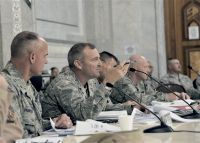CAMP VICTORY, Iraq — After spending more than a year coordinating airpower in Iraq and helping to ensure U.S. forces there drew down to less than 50,000 boots on the ground, the top airman in Iraq is headed home.
Serving as the director of the Air Component Coordination Element in Iraq, the director of the force strategic engagement cell for U.S. forces in Iraq, and the 9th Air Expeditionary Task Force-Baghdad, Detachment 2 commander, Maj. Gen. Joseph Reynes Jr. has watched the number of servicemembers in Iraq decrease from 148,000 to almost 50,000, and the number of airmen decrease from more than 12,000 to fewer than 6,000.
Reynes explained the mission the Air Force has had in Iraq during his 18-months-plus tenure.
“We’ve provided timely and precise air mobility,” he said. “We’ve had 24/7 unblinking [intelligence, surveillance and reconnaissance] to cover and work with our joint force partners. And then, of course, we’ve had kinetic and non-kinetic operations at the discretion of the commanders in support of their missions.
“It’s been an awesome mission that we’ve executed over and over again, and we’ve just gotten better every day,” the general added.
U.S. forces in Iraq have transitioned from Operation Iraqi Freedom to Operation New Dawn. And, although the Air Force’s mission in Iraq will mostly stay the same, Reynes said, it will continue to evolve.
“What’s evolved is how we translated those missions, and how we’ve drawn down at the same time,” Reynes said. “[We’re] executing the same missions, 24/7, 365 [days a year], in support of the ground force commander. And they’ve done that while we’ve done one of the most historic drawdowns, while executing the mission at the same time.”
Moving into Operation New Dawn means adapting to a smaller footprint for U.S. airmen and growing capabilities for Iraqi airmen, the general said. It’s a new beginning for Iraq, he said, noting the Iraqi air force has grown from 1,500 airmen and 28 aircraft two years ago, to 7,000 airmen and more than 100 aircraft now.
The Iraqi air force is expected to grow to more than 10,000 members by 2012, Reynes said. Meanwhile, he said, Iraqi airmen are beginning to move onto bases such as Joint Base Balad, and Ali and Sather air bases.
“We’ll continue to support and do the same missions we’ve done, but at the same time we’re handing more and more off to our Iraqi partners,” Reynes said. “And over the next year, you’re going to see more partnering with our Iraqi brothers and sisters, but also we’ll be doing more training.
“[It’s a] mission they want to do and execute,” he said of Iraq’s airmen. “And we’re working with them to ensure they are the best they can be.”
As the drawdown continues, about 6,000 U.S. airmen will remain in Iraq, Reynes said. The Air Force footprint has gotten smaller, he said, but airmen will retain the same capabilities to execute a variety of missions in support of ground forces.
“Operation New Dawn really doesn’t change anything for our airmen,” Reynes said. “They are still going to be executing the same missions as they were before, but there will be fewer airmen. We’re still going to be providing ISR [intelligence, surveillance and reconnaissance].” We’re still going to be providing timely and precise cargo and passenger movement. And of course,” he continued, “every day and every night there are going to be aircraft airborne, just in case kinetics are needed, and in more cases, just for that presence over the battlefield for 24/7, 365 [days a week] overwatch.”
While doing all of this, airmen will be training Iraqi airmen throughout the country so they can completely take over the mission by the end of 2011, the general said.
“Airmen will be partnering with our Iraqi brothers as we develop the Iraqi air force, as we continue to work to develop those partnerships and engagements with our Iraqi brothers and sisters as we move toward end of mission,” he said.
Source:
U.S. Department of Defense
Office of the Assistant Secretary of Defense (Public Affairs)

 von
von 